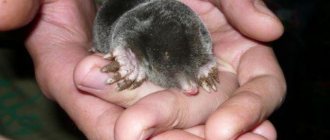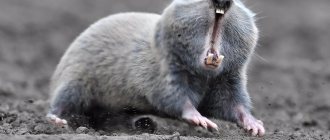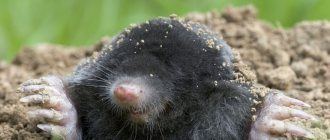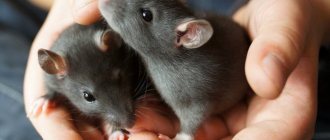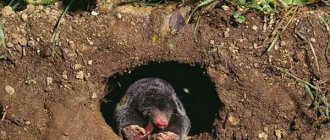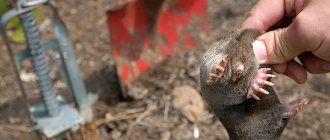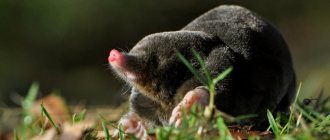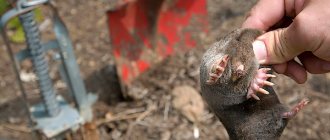Name: Common, South Russian and small-eyed mole rat Lat.:
Spalax microphthalmusClass: Mammals - Mammalia Order: Rodents - Rodentia Family: Mole rats - Spalacidae
| Habitats: | garden |
| Dangerous for: | roots, bulbs and rhizomes |
| Description: | A year-round active animal with a big appetite. |
Description and photo of the animal mole rat
Mole rat.
Mole rats are small animals of the rodent order. Their lifestyle is similar to moles, but outwardly they have significant differences.
Appearance of the animal
Adults can weigh up to 700 grams or more. The animal's body reaches 20-32 cm in length and has an oblong, cylindrical shape. The fur is thick, short, and colored pale gray-brown.
The neck is poorly defined. The legs are very short. The tail is not developed and is hidden under the skin. The head is the widest part of the animal's body and has a flattened shape. The animal has no ears, and its eyes are hidden under the skin. The incisors are pronounced and grow on top of the lips.
Have you seen a mole rat?
Not really
Lifestyle of mole rats
Mole rats on the surface of the earth are a rare occurrence.
The animals spend almost their entire lives underground. The burrow system of this animal is very well branched and has two tiers. The so-called “feeding passage” is the longest and is located at a depth of 20-25 cm. The mole rat’s home is equipped with summer and winter nests, as well as storage facilities for food supplies.
Unlike moles, mole rats make their way with the help of incisors. From the soil that the animal pushes out, characteristic mounds are formed - “mole rats”. The diameter of such “mole rats” can reach 50 cm. The total length of moves made by one rodent can be up to 450 m.
Mole rats do not hibernate in winter and therefore store large reserves of food. Winter supplies of one such rodent can weigh up to 14 kg.
What does the animal eat?
The diet of mole rats consists mainly of plant foods. The animal feeds on bulbs, tubers and rhizomes of various plants. Sometimes a rodent can feast on young stems and leaves, which it drags underground by grasping the rhizome.
Among the animal's winter supplies you can find acorns, onions, potatoes and beets.
Reproduction
An enemy in a fur coat.
Mole rats usually live in groups of 2-3 individuals, including one male and 1-2 females. If there is more than one female in a family, then they take turns producing offspring.
Cubs are born in the spring. Around this time, the male leaves the female who gave birth and goes to the one who will bear offspring next year.
One litter produces 2-3 cubs. Young females begin to move away from their mother already in the first year after birth. They settle mainly closer to the surface, so they often die before reaching two years of age. The mortality rate among young males is much lower, because they move away from their mother only in the second year and settle underground.
The average lifespan of mole rats in the wild is 2.5-4 years. Some specimens can live up to 9 years.
Litmus test
The common shrew is considered a pest because it eats the eggs of commercial fish. But when it began to disappear en masse in many areas of its former range, it was immediately forgotten. Just as biologists use mice to understand the level of pollution in forests and fields, so the shrew serves as a litmus test for the ecology of water bodies.
Anna Zvyagintseva, a resident of the Krasnogvardeisky district, described her uncle’s meeting with this animal:
“When he was sitting on the ice with a fishing rod, the cutter itself ran up to him and hid under his boot. He started filming it on his phone to show it to me. How interesting it was to watch her! She dived into a hole made for fishing and swam in the snow. And then the second one appeared. What they did together is beyond words! It turns out that the shrew, listed in the Red Book, lives on our Userdets River.”
After reading online sources, I learned that the Russian muskrat and the common shrew settle in oxbow lakes, small quiet backwaters, but always in ecologically clean rivers with forests along the banks. This means that the Userdets River is an environmentally friendly reservoir.”
Mole rat habitat
The habitat of mole rats includes steppe, forest-steppe, semi-deserts and deserts. Most often the animal is found in steppe and flat areas. Since mole rats feed mainly on plant foods, they happily settle in grassy meadows and clearings. In rare cases, mole rats can be found on the outskirts of forests.
When choosing soil, rodents prefer moderate density.
In clay and sandy soils, the mole rat most likely will not stay long.
The animals also do not particularly like salt marshes and wet areas.
Is the mole rat the same mole?
No, this is a wrong opinion. Animals are different, although they have a similar lifestyle.
Do mole rats bite?
Yes, and very much so. But he does not attack himself, but only in case of self-defense. His vision is not developed at all and in case of danger he attacks everyone and everything, relying only on hearing.
How likely is it to meet him?
Although the population is quite large, it is unlikely to encounter a mole rat. If it accidentally hits the surface, it freezes, listening and orienting itself, then backs away to get into its hole.
Mole nutrition
Moles are insectivores; the basis of their diet are earthworms. They collect them in feeding passages, and the worms themselves crawl into these holes, attracted by the smell secreted by the mole.
The mole is a mammal that leads a 24-hour, year-round lifestyle. It feeds 3-4 times a day, eating about 20-30 grams of worms.
After feeding, the mole moves to the nesting hole and, curled up in a ball, goes to sleep for 3-5 hours, after which it again begins to search for food.
If an animal finds more worms than it can eat, the mole takes them to special storage places, a kind of storehouse, after first biting off their heads, and returns to eating them after waking up.
How to deal with a pest
The mole rat is a rodent whose habits are very similar to the mole. They are often even confused due to similar dietary preferences. The fight against mole rats is carried out using the same methods as with moles. For more information about them, follow the links below to the portal articles.
Plants are a safe way to protect your area from moles and other rodents.
Mole traps allow you to catch the pest quickly and easily.
The greenhouse requires protection from moles; they are comfortable there at any time.
Proven methods of controlling moles on the site. Fast and efficient.
What do moles and shrews eat?
In addition to worms in the diet of moles
includes mole crickets, chafer larvae, caterpillars, and various small insects.
Sometimes they come across larger prey - mice, sick and weakened rats, lizards, small snakes and other snakes, frogs, shrews
.
Interesting materials:
How to connect your phone to TV using Wi-Fi? How to connect your phone to TV using wifi? How to connect your phone to a Samsung 7 series TV? How to connect your phone to a Samsung TV wirelessly? How to connect your phone to a Samsung TV without a smart TV? How to connect your phone to a Samsung TV via Wi-Fi? How to connect your phone to a Samsung TV? How to connect your phone to a Sharp TV? How to connect your phone to Skyward TV? How to connect your phone to a Smart TV?
Reproduction and lifespan
Moles are solitary animals; they pair up only during the breeding season to procreate. By the age of one year, moles reach sexual maturity.
The breeding season occurs once a year in early spring. The female prepares the nest alone for the brood; the male does not participate in this.
Forty days after conception, small, completely hairless cubs are born. There are usually about five of them in a litter, less often it reaches 8-9 individuals.
In the photo there are baby moles
For a month, the offspring stay with the female, who brings them food and cares for her children. Subsequently, the young leave the female’s burrow and begin to build their own home. If the young brood does not leave the nest, then the female may even bite it, thereby driving it into independent adulthood.
What kind of life do they lead?
Moles are almost always underground. All individuals are equally active both at night and during the day. Over the course of a day, animals experience several three- to four-hour stages of increased mobility, and in the intervals between them the animals rest in their nests.
Moles are characterized by a predominantly sedentary lifestyle. Only sometimes, in hot weather and drought, do they move approximately 1–1.5 km from their habitats in search of water.
Moles are loners. They live in their own individual plot, which they bravely defend from enemies to the best of their ability. Each of them has its own tunnel system, but sometimes they overlap. The animals still try not to collide with each other and get food in various secluded corners.
If a mole dies, the neighbors quickly notice it, and the fastest one wins the free area. Sometimes it is shared by several animals.
Having captured a certain territory, moles mark the tunnels laid there with a powerfully smelling secretion secreted by the preputial glands. Both males and females have this smell. If this “aroma” is not present, other individuals will conquer the area.
Natural enemies
Moles have relatively few enemies as such. The powerful smell protects them from foxes. They are only suitable for food for badgers. Sometimes dogs and cats hunt animals, but not to kill them, but out of “sporting interest.”
Pets can control the number of moles in their garden. In those households where dogs and cats live, there are almost no moles.
Places where moles live
Moles like to inhabit the following places:
- meadows;
- forest clearings;
- birch forests and copses;
- areas near roads;
- parks within the city;
- garden and vegetable plots.
Molehills are often found where the soil is enriched with humus, populated by worms, arthropod larvae, and heated by the sun. Soil moisture is also of great importance; it should have average values.
Traces of moles are unlikely to be found in the following places:
- dense forest;
- Pinery;
- swampy places;
- places where plants with strong roots grow.
The mole’s choice of place to live also depends on the annual amount of precipitation and soil temperature. If the climate in the area is not stable, moles move closer to the forest, where the depth of soil freezing in winter is less, and in summer moisture in the soil is better retained.
The mole will constantly change its location until it finds comfortable living conditions for itself.
Interesting Facts
Despite their “banality” and familiarity, moles are a unique family that is interesting to both scientists and ordinary people.
People may not know everything about moles, but they have collected a number of facts about them:
- In construction, the mole uses not only its paws, but also its nose.
- In one minute the animal digs up to 30 cm of soil.
- Sometimes moles eat their dead or weakened relatives.
- The speed of movement of the animal through the tunnel is 25 m/s.
- There is a bone in the reproductive organ of male moles.
- Moles are not actually blind; their eyes are simply covered with skin to prevent dirt from falling into them.
- Moles, along with snakes, are never found in Ireland.
- Even if the animal is moved to another place, it somehow still finds its way home.
- The average length of a mole hole is 200 meters.
- Ordinary moles are not found in Australia, and their ecological niche is occupied by marsupial moles - animals with orange fur.
- If you start feeding the animal artificially, it will stop moving and will soon die from obesity.
- Golden moles (golden moles) living in South Africa are not moles.
The mole is a very peculiar animal that brings both harm and benefit to agriculture. Its lifestyle is typical for an underground animal, although it has its own characteristics. There are more than 40 species in the Mole family, many of which are found in Russia.

